| |
Other Foreign
Awards to German Overseas Forces
It sometimes
happened that German colonial and overseas troops were awarded
medals by other countries. This usually occurred when they were
temporarily in the service of another country or were allied to
and serving alongside foreign soldiers. On other occasions
medals were awarded to German troops by visiting (or visited)
foreign royalty, often when that royalty served as honorary
colonels-in-chief of regular German army regiments. Foreign medals were always worn after all German awards
in the order of seniority on a medal bar.
The Medals Bar Page and Ribbon Bars Page of this website show that medals from many foreign countries
(including Ottoman Turkey, Austria-Hungary, Belgium, Great Britain, Greece, Chile, Sweden, the Netherlands, Belgium,
Portugal and Russia) were awarded
to German overseas servicemen.
During
the First World War, medals that had previously been awarded by
Entente countries were usually removed from uniforms. Also
during the First World War awards were received from
other allied or neutral countries such as Bulgaria
(by German soldiers in Macedonia) and Finland and Sweden (by
German soldiers
in the Baltic Sea Division).
| Austro-Hungarian Awards |
|
|
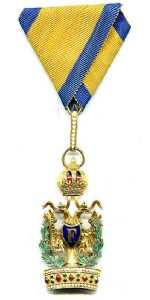
Order of the Iron Crown
Third Class
with war decoration
Photo from WikiCommons |
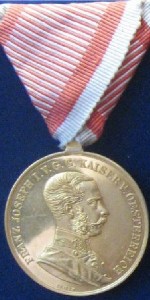
Gold Bravery Medal
Photo from
HGM, Vienna / WikiCommons |
|
|
Austro-Hungarian medals were
often awarded to German troops who served alongside them. For
example Gefreiter Franz Pauly and Musketier Heinrich
Halves, both of 2nd Battalion, 2nd East Asian Infantry
Regiment were awarded the Golden Bravery Medal in 1901
for action in the Boxer Rebellion.
During the First World
War, German troops serving alongside their
Austro-Hungarian allies were again awarded Austro-Hungarian
medals. A
particular case with Germany's overseas troops was the Seebataillon
detachment based at Skutari ("Marine Detachment Skutari") in
Albania who were awarded a total of sixteen Austro-Hungarian medals
(one Third Class Order of the Iron Crown with war
decoration, one Golden Bravery Medal, four First Class
Silver Bravery Medals and ten Second Class Silver
Bravery Medals)
while serving under Austro-Hungarian command against the Serbian
army at the outbreak of the First World War.
Austro-Hungarian medals
were traditionally worn with the ribbon folded into a point-down
triangle. When worn by German servicemen they were sometimes kept in
this style and at other times re-folded in the German
manner. Similarly Austro-Hungarian soldiers with German
awards usually wore them with a triangular folded
ribbon. After Austria was annexed
into the German Reich in 1938, their medals were no
longer counted as foreign and were worn with a similar
seniority to those of other German states (such as
Bavaria and Saxony) but behind those of Prussia.
Recommended External Links - Foreign Awards at the Austro-Hungarian Army Website and Austro-Hungarian medals at the GWPDA |
| |
|
|
| Georgian Order of St
Tamara |
|
|
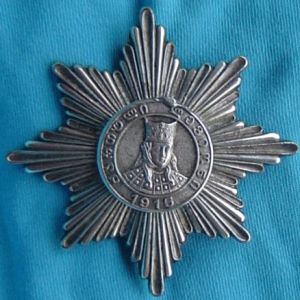
Photo © Matjaz Voglar |
|
This was a medal awarded to members of the German Caucasian
Expedition by
the fledgling Georgian Government on 4th November 1918. It was named
after the 12th-13th Century Sainted Queen of Georgia.
The award consisted
of an image of Queen Tamara within a circle containing Georgian
lettering and the date 1915 on an eight pointed Brunswick star badge
worn on the left breast. Originally in white metal, several
variations were later made for private purchase by
veterans in Germany after the war. The example pictured
on the left is one such medal. Others were more ornate
with enamelled centres.
It could also be worn as a ribbon
without the medal (such as on miniature bars). The ribbon was
dark red with black horizontal bars in the centre. Less than 5,000
of these medals (some say as few as 1,400) were awarded in total,
most of the existing medals were privately made in Germany after the
First World War for veterans of the Georgian Campaign.
Recommended External Links-
Sections on the Order of St Tamara at The Orders and Medals Society of America, The Gentlemen's Military Interest Club and Wehrmacht
Awards and Wikipedia
|
| |
|
|
| Egyptian Khedival Star |
|
|
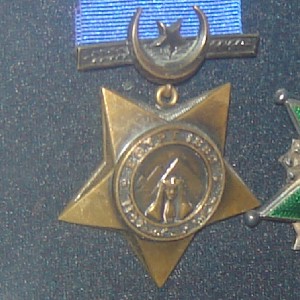
Photo by C Dale from the Royal Fusiliers Museum Collection |
|
The Khedival Star was
awarded by Khedive Tewfik, the ruler of Egypt to those soldiers,
sailors and civilians who fought in his service between 1882 and
1891. As such it was awarded to many Sudanese askaris who later
served in the Wissmanntruppe and the Schutztruppe of German
East Africa. This Egyptian medal continued to be worn by many of
them while in German service.
It consisted of a brass
five pointed star with "Egypt 1882" in English and Arabic around a
sphinx and three pyramids in the centre. The star itself hung from a
brass crescent and star motif on a dark blue ribbon.
This particular Khediveal Star shown
in the photograph was awarded to the British Officer, Major General
Sir Geoffrey Barton KCVO CB CMG
Recommended External Link - British Medals
|
| |
|
|
| British Egypt Campaign Medal |
|
|
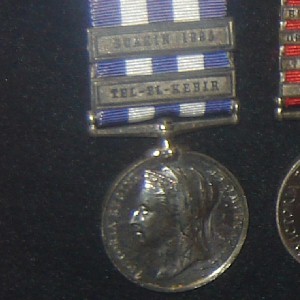
Photo by C Dale from the Royal Fusiliers Museum Collection |
|
The Egypt Medal was
awarded by the British government to soldiers serving in Egypt in
1882 and in the Sudan, 1884-89. As such it was awarded to many
Sudanese askaris who later served in the Wissmanntruppe and
the Schutztruppe of German East Africa. This British medal continued
to be worn by many of them while in German service.
It consisted of a white
metal round medal with "Victoria Regina et Imperiatrix" ("Queen and Empress
Victoria" in Latin) around Queen Victoria's profile and had
a dark blue ribbon with two vertical white stripes. It could
be awarded with one or more white metal clasps for different battles
or campaigns.
This particular Egypt
Medal shown in the photograph was awarded to the British Officer,
Major General Sir Geoffrey Barton KCVO CB CMG and has clasps for "Suarin
1885" and (the 1882 Battle of) "Tel-El-Kebir".
Recommend External
Link - North East Medals
|
| |
|
|
|
Chinese Order of the Double Dragon |
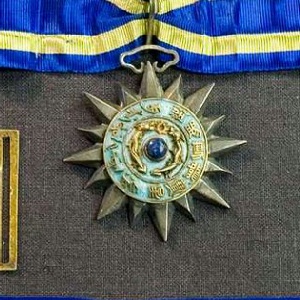
Photo from the Armémuseum, Stockholm / WikiCommons |
|
The
Imperial Order of the Double Dragon was instituted by the
Chinese Emperor Guangxu on 7th February 1882 as a reward
specifically for foreigners who had performed services
to the Chinese throne. As such it was awarded to German diplomats and
officers based in China as well as back at home. The
German Admiral Hans von Koestler who had ordered the
German occupation of the Kiaochow province was a notable
recipient of the Order. From 1908 it was also awarded to Chinese
subjects.
Recommended External Link - Diplomat with the Chinese Double Dragon at the Gentlemen's Military Interest Club
During the
Boxer Rebellion the armies of the Eight Nation Alliance
frequently awarded medals to each others soldiers.
German soldiers were therefore the recipients of foreign
medals from their allies, for example Graf von Soden
(who commanded the small detachment of German Marine
Infantry inside the Peking Legations) was awarded the
French Legion of Honour, the Italian Order of the Crown,
the Russian Order of St Anne, the Belgian Order of
Leopold, the Greek Order of the Redeemer and the
Austro-Hungarian Order of the Iron Crown as well as the
Prussian Pour-le-Mérite and many other German awards for
his actions.
Recommended External Link - Russian Medals
to German Forces in China 1901 at the Gentlemen's Military Interest Club |
| |
|
|
| Chilean Commemorative Medal for
German Officers |
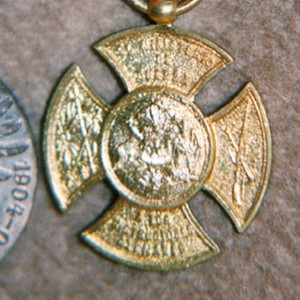
Photos © Traditionsverband |
|
| Some German officers earned medals while attached to
foreign armies in a training role. For example thirty-one German
officers were awarded the unique "Chilean
Commemorative Medal for Training Officers" for
their service in the Chilean army in the late
1890s.
Among their number were at least three future
Schutztruppe officers: Friedrich von Erckert
(later known as the founder of the South West
African Schutztruppe Camel Company), Friedrich
von Lettow-Vorbeck (brother of the East African
Schutztruppe commander) and Karl Zimmermann
(later known as the commander of the Cameroon
Schutztruppe during the First World War).
Recommended External Link - Der
chilenische Orden des Hauptmann Friedrich von Erckert at Traditionsverband |
|
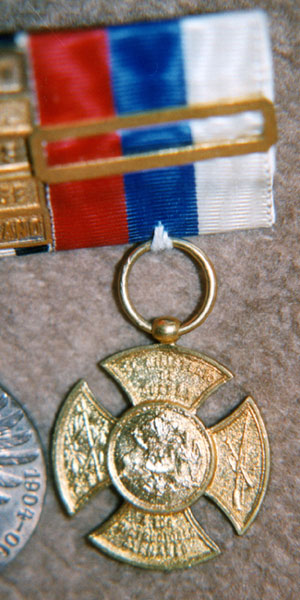 |
|
|
|